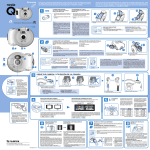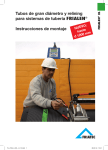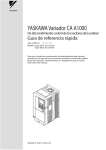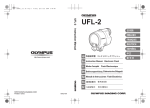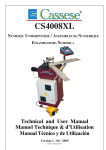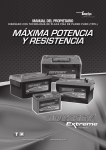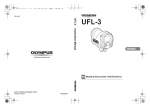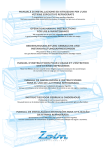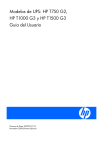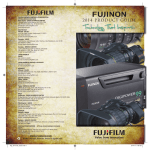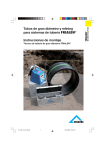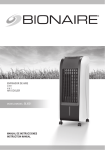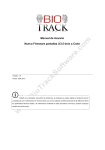Download 202b10229520 u owner`s manual manual de instrucciones english
Transcript
• • • • • Fujinon 38-90mm Auto Focus Zoom Lens Automatic Exposure and Automatic Flash Operation Self-Timer Red-Eye Reduction Flash Date/Time Imprinting ENGLISH/ESPAÑOL OWNER’S MANUAL MANUAL DE INSTRUCCIONES 202B10229520 U CONTENTS FEATURES ............................................................................... 2 PART NAMES ........................................................................... 4 Liquid Crystal Display ............................................................. 6 Viewfinder ............................................................................... 7 1. PRELIMINARY STEPS ATTACHING THE STRAP ........................................................ 8 LOADING THE BATTERIES .................................................... 9 TURNING ON YOUR CAMERA ............................................. 11 CHECKING YOUR BATTERY ................................................ 12 SETTING THE DATE (YEAR-MONTH-DAY/HOUR-MINUTE) .................................. 13 SELECTING THE DATE MODE ............................................. 16 2. USING YOUR CAMERA LOADING THE CAMERA ....................................................... 17 USING YOUR CAMERA ......................................................... 21 USING THE AUTO-FOCUS LOCK ........................................ 26 UNLOADING THE FILM OR REMOVING FILM IN MID-ROLL ................................................................. 28 3. ADVANCED TECHNIQUES SELECTING THE EXPOSURE MODE .................................. 32 Effective flash range ............................................................. 34 2 ENGLISH USING THE SELF-TIMER ...................................................... 40 TROUBLE SHOOTING ........................................................... 42 COMMON SENSE CAMERA CARE ...................................... 48 SPECIFICATIONS .................................................................. 50 IMPORTANT SAFETY NOTICE ............................................. 54 FEATURES • • • • • Fujinon 38-90mm Auto Focus Zoom Lens Automatic Exposure and Automatic Flash Operation Self-Timer Red-Eye Reduction Flash Date/Time Imprinting The “CE” mark certifies that this product satisfies the requirements of the EU (European Union) regarding safety, public health, environment and consumer protection.(“CE” is the abbreviation of Conformité Européenne.) This product is in conformity with Directive 89/336/EEC. ÍNDICE CARACTERÍSTICAS ................................................................ 3 NOMBRE DE LAS PARTES ..................................................... 4 Panel de Cristal Líquido (LCD) .............................................. 6 Visor ........................................................................................ 7 1. OPERACIONES PRELIMINARES COLOCACIÓN DE LA CORREA .............................................. 8 COLOCACIÓN DE LAS PILAS ................................................. 9 PARA ACTIVAR/DESACTIVAR LA CÁMARA ....................... 11 COMPROBACIÓN DE LAS PILAS ......................................... 12 AJUSTE DE LA FECHA (AÑO-MES-DÍA/HORA-MINUTOS) ........................................ 13 SELECCIÓN DEL MODO DE LA FECHA .............................. 16 2. UTILIZACIÓN DE LA CÁMARA COLOCACIÓN DE LA PELÍCULA .......................................... 17 UTILIZACIÓN DE LA CÁMARA ............................................. 21 USO DEL BLOQUEO AF (ENFOQUE AUTOMÁTICO) ........ 26 EXTRACCIÓN DE LA PELÍCULA/ EXTRACCIÓN DE LA PELÍCULA A MITAD DE ROLLO ...................................... 28 3. OPERACIONES AVANZADAS SELECCIÓN DEL MODO DE EXPOSICIÓN ......................... 32 Gama de alcance del flash ................................................... 34 ESPAÑOL EL DISPARADOR AUTOMÁTICO ......................................... 40 FALLOS, CAUSAS POSIBLES Y SOLUCIONES .................. 44 CONSERVACIÓN DE LA CÁMARA Y PRECAUCIONES ..... 49 CARACTERÍSTICAS TÉCNICAS ........................................... 52 ADVERTENCIAS Y PRECAUCIONES .................................. 56 CARACTERÍSTICAS • • • • • Objetivo autofocus Fujinon con Zoom de 38-90mm Exposición y flash automáticos Autodisparador Reducción del efecto “ojos rojos” Impresión de fecha/hora La marca “CE” certifica que este producto cumple los requisitos de la UE (Unión Europea) en lo que se refiere a la seguridad, la salud pública y la protección del medio ambiente y del consumidor. (“CE” es la abreviatura de Conformité Européenne). Producto conforme con la Normativa 89/336/EEC. 3 PART NAMES/NOMBRE DE LAS PARTES 7(→p.30) 1(→p.32) 2(→p.11) 3(→p.23) 4 5 8(→p.40,13,15) 9(→p.13,16) 0(→p.6) A(→p.32) B(→p.35,41) C 6(→p.8) D(→p.11) ENGLISH 1 2 3 4 5 6 7 8 9 0 A B C D Exposure Mode Button Power Button Shutter Release Button Viewfinder Window AE Light Sensor Strap Lug Mid-Roll Rewind Button Self-timer/SET (Date Set) Button DATE/SEL (Date Select) Button Liquid Crystal Display Flash Red-eye Reduction/ Self-Timer Lamp AF (Auto-Focus) Window Fujinon Lens/ Lens Cover ESPAÑOL 1 2 3 4 5 6 7 8 9 0 A B C D 4 Botón de modo de exposición Botón de alimentación Disparador Ventanilla del visor Fotosensor de exposición automática Anclaje de Ia correa Botón de rebobinado a mitad de rollo Botón de disparador automático/SET (Ajuste de la fecha) Botón DATE(Fecha)/SEL (Selección de la fecha) Panel de Cristal Líquido (LCD) Flash Piloto de reducción del efecto “ojos rojos”/ Disparador automático Ventanilla AF (enfoque automático) Objetivo Fujinon/Tapa del objetivo ENGLISH E(→p.23) I(→p.22) J(→p.18) K F(→p.7) E F G H I J K L M G(→p.19) N O P H(→p.19) L(→p.18,29) M(→p.9) N AF Lamp (green) Viewfinder Eye-piece FILM TIP Mark Film Take-up Spool Zoom Button Film Confirmation Window Film Pressure Plate Camera Back Battery Compartment Cover Film Chamber Tripod Socket Camera Back Lock ESPAÑOL E Piloto AF (verde) F Ocular del visor G Marca del extremo de la película H Bobina de recogida de la película I Botón del zoom J Ventanilla de verificación de la película K Placa de presión de la película L Tapa posterior de la cámara M Tapa del compartimento de las pilas N Compartimento de la película O Zapata para trípode P Cierre de la tapa posterior de la cámara O P(→p.18,29) 5 ENGLISH Liquid Crystal Display/ Panel de Cristal Liquido (LCD) Q(→p.38) U(→p.12) R(→p.35) V(→p.20,40) S(→p.37,23) T(→p.39) W(→p.40) X(→p.13,16) 6 Q Landscape Mode R Red-eye Reduction Flash Mode S Back Light Compensation Flash Mode Flash-off Mode Flash Charging T Night Portrait (Slow Sync) Mode U Battery Status V Picture Counter/Selftimer Count W Self-timer Mode X Date Display ESPAÑOL Q Indicador del modo paisajes R Indicador del modo de reducción del efecto “ojos rojos” S Flash de compensación de contraluz Flash desactivado Carga del flash T Indicador del modo de retrato nocturno (sincronización lenta) U Indicador de capacidad de las pilas V Contador de exposiciones/ Contador del disparador automático W Indicador del modo del disparador automático X Visualización de la fecha ENGLISH Viewfinder/Visor A : Framing area Compose the image within this area. C B : AF (Auto-focus) spot Position this spot over the main subject in your picture. C : Parallax correction guides A B When taking pictures at close distances (Closer than 1.5 m/4.9 ft.), use these indicators as a guide when composing your picture. (→p.24) ESPAÑOL A : Área de encuadre Componga la imagen dentro de esta zona. B : Recuadro AF (enfoque automático) Coloque este recuadro sobre el sujeto principal de la fotografía. C : Marcas de corrección de paralaje Cuando se toma una fotografía de un primer plano, utilice estas marcas como una guía para componer la fotografía. (→pág.24) 7 ENGLISH 1 1. PRELIMINARY STEPS ESPAÑOL 1. OPERACIONES PRELIMINARES ATTACHING THE STRAP COLOCACIÓN DE LA CORREA Slip the thin piece of the camera-strap through the small hole on the left side of the camera and leave a loop. Slide the thick part of the strap through this loop and pull tight. Take up any slack to make sure the strap is tightly on the camera. Pase el extremo de la correa por el ojal situado en el lateral de la cámara y sujételo como indica la ilustración. Do not use a strap made for cellular phones or other similar electronic products. These straps are usually too weak to hold your camera securely. For safety, use only straps designed for cameras. Al usar una correa de tipo convencional, confirme que esté en buenas condiciones y compruebe su resistencia. Tenga mucho cuidado al utilizarla porque generalmente son usadas para artículos de bajo peso. 2 8 ENGLISH 1 2 3 ESPAÑOL LOADING THE BATTERIES COLOCACIÓN DE LAS PILAS Your camera requires two alkaline batteries (Size AA/LR6) for reliable service. To load the batteries: 1 Flip open the battery compartment cover. Su cámara utiliza dos pilas alcalinas (LR6 de tamaño AA) o equivalentes. Para cargar las pilas: 1 Abra la tapa del compartimento de las pilas. 2 Load the batteries following the instructions shown in the diagram on the inside of the battery compartment cover. Important: Pay careful attention to the polarity of the batteries as indicated by the , and . markings on the battery. The batteries must be loaded the correct way or the camera will not work. 3 When the batteries are loaded correctly, close the battery compartment cover by pressing it until it snaps into place. If it does not snap into place, do not force it but recheck the position of the batteries. 2 Inserte las pilas siguiendo las instrucciones que se indican en la parte interior de la tapa del compartimento de las pilas, prestando especial atención a la posición de los polos , y .. 3 Una vez insertadas las pilas de forma correcta, cierre la tapa del compartimento de las pilas de modo que quede bien trabada. 9 ENGLISH ∗ ∗ ∗ ∗ ∗ ∗ ∗ ∗ 10 Do not apply force when opening or closing the battery compartment cover. Make sure that new replacement batteries are both same brand and type. Do not use Ni-Cd batteries. Two alkaline batteries should be enough for about 240 pictures (based on our test conditions). When traveling, take extra batteries in the event the batteries stop working. This is important if you visit areas where new batteries may be difficult to get. Check the battery capacity before you use your camera. (→p.12) After changing the batteries, reset the date to get the right date/ time recording. (→p.13) When it is cold, batteries will not work as well. Warm the batteries, e.g. in your pocket, before using them. ESPAÑOL ∗ ∗ ∗ ∗ ∗ ∗ ∗ ∗ No ejerza demasiada fuerza sobre la tapa del compartimento de las pilas. Asegúrese de que las nuevas pilas sean ambas de la misma marca y tipo. No utilice pilas Ni-Cd. Dos pilas alcalinas son suficientes para realizar 240 fotografías aproximadamente (dato basado en nuestras condiciones de prueba). Si se utilizan muchas películas, por ejemplo al realizar un viaje, se recomienda llevar pilas de reserva (especialmente en zonas en las que podría ser difícil adquirirlas). Compruebe el indicador de capacidad de las pilas antes de utilizar la cámara. (→pág.12) Después de cambiar las pilas, vuelva a fijar la fecha. (→pág.13) A baja temperatura se reduce la capacidad de las pilas. Caliéntelas, por ejemplo en el bolsillo, antes de utilizarlas. ENGLISH TURNING ON YOUR CAMERA Before you can use your camera, you must turn the power on. First press the power supply button which turns on the power. Pressing this button a second time will turn the power off. ☞ When you turn your camera on, the lens ESPAÑOL PARA ACTIVAR/DESACTIVAR LA CÁMARA Pulse el botón de alimentación para activar la cámara y vuélvalo a pulsar para desactivarla. ☞ Cuando se activa la cámara, la tapa del objetivo se abre y en el panel LCD aparecen las indicaciones de inicio. cover will open and the initial display will appear on the LCD. ∗ When you are finished using your camera, turn the power off to keep your battery working well longer. If the power supply is left on for more than 7 minutes without the camera being used, the camera will turn itself off. Before you turn the camera on, make sure that the lens is not blocked by anything that would interfere with the lens extending into picturetaking position. ∗ Si la cámara permanece activada sin utilizarse durante más de 7 minutos, se desactivará de forma automática. Antes de activar la cámara, asegúrese de que el objetivo no esté obstruido para facilitar así su extensión a la posición de toma de fotografías. 11 ENGLISH 12 ESPAÑOL CHECKING YOUR BATTERY COMPROBACIÓN DE LAS PILAS To determine the capacity of the battery in your camera, turn the camera on and check the battery indicator on the LCD panel. 1 Lit : Battery is OK. 2 Lit : Battery is low. Replace with new batteries. 3 Blinks: Shutter cannot be released because battery is dead. Replace with new batteries. Active la cámara y compruebe el indicador de capacidad de las pilas en el panel LCD. 1 Iluminado : La carga de las pilas es correcta. 2 Iluminado : La carga de las pilas es insuficiente. Coloque pilas nuevas. 3 Parpadea : El obturador no dispara porque las pilas están agotadas. Sustitúyala. ∗ ∗ ∗ ∗ Check the battery capacity before you use your camera. The battery can be replaced even while there is a partially exposed roll of film in the camera. Compruebe el indicador de capacidad de las pilas antes de utilizar la cámara. Las pilas se pueden sustituir aunque haya película parcialmente expuesta. ENGLISH SETTING THE DATE (YEAR-MONTH-DAY/ HOUR-MINUTE) 1 2 2 Setting the date when loading or changing the batteries. Ajuste de la fecha cuando se colocan o cambian las pilas. Turn the camera on and then press the DATE button. Active la cámara y pulse el botón DATE. ☞ The “Year” blinks and the camera will enter 1 ESPAÑOL AJUSTE DE LA FECHA (AÑO-MES-DÍA/ HORA-MINUTOS) the date setting mode. Year : ’02 to ’32 (2002 to 2032) Month : 1 to 12 Day : 1 to 31 Time : 0 to 23 hours; 00 to 59 minutes (Based on a 24-hour clock) 1 Press the SET button to change the blinking setting. 2 Press the SEL button to select the next part of the date/time information. ☞ Each press of the SEL button selects a different element in the date/time information in the following order: Year→Month→Day→Hours→Minutes ☞ El “Año” parpadea y la cámara entra en el modo de ajuste de fecha. • Ajuste Año : ’02 a ’32 (2002 a 2032) Mes : 1 a 12. Día : 1 a 31 Horas : 0 a 23. Minutos : 00 a 59 1 Pulse el botón SET para modificar el valor que esté parpadeando. 2 Pulse el botón SEL para seleccionar el siguiente elemento de la fecha u hora. ☞ Cada vez que pulse el botón SEL, seleccionará un elemento distinto de la indicación de fecha y hora en el orden siguiente: año→mes→día→horas→minutos 13 ENGLISH 3 Pulse el botón DATE/SEL después de haber modificado los “Minutos” para salir del modo de ajuste de fecha y hora. press the DATE/SEL button when the time signal indicates zero. radio, pulse el botón DATE/SEL cuando la señal horaria anuncie cero. ☞ To set the time (hour or minute) by the radio, ∗ 14 ESPAÑOL To cancel the date/time setting mode, press the DATE/SEL button after changing the “Minutes”. The year, month, and day will change together with the hour and minute. ☞ Para ajustar la hora o los minutos según la ∗ El año, el mes y el día cambian conjuntamente en función de la hora y de los minutos. ENGLISH Changing the date after setting it. 1 Turn the camera on and then hold down the DATE button for at least 2 seconds or longer. ☞ The “Day” blinks and the date change mode is entered. ESPAÑOL Cambio de la fecha después de haberla puesto. Active la cámara y mantenga pulsado el botón DATE durante 2 segundos aproximadamente o más. ☞ El “Día” Parpadea y se activa el modo de cambio de la fecha. 2 2 Using the process described in steps 2 1 to 2 on page 13, set the date with the SET and SEL buttons. Ajuste la fecha con los botones SET y SEL siguiendo el procedimiento descrito en los pasos 2 1 a 2, en la página 13. ferent element in the date/time information in the following order: Day→Hours→Minutes→Year→Month ☞ Press the DATE/SEL button after changing the “Month”. nará un elemento distinto de la indicación de fecha y hora en el orden siguiente: día→horas→minutos→año→mes ☞ Pulse el botón DATE/SEL después de haber modificado el “Mes”. ☞ Each press of the SEL button selects a dif- 1 ☞ Cada vez que pulse el botón SEL, seleccio- 15 ENGLISH SELECTING THE DATE MODE The date and time (year-month-day/ hourminute) will be printed at the lower right of the picture. ∗ ∗ Y M D M D Y D M D 16 The date display printed on the front of the picture may not be clearly visible against a dark background. Since the date is printed on the film when the picture is being advanced, the date may not be printed on the last frame when more than the standard number of frames are taken. ESPAÑOL SELECCIÓN DEL MODO DE LA FECHA La fecha y la hora (año-mes-día/horaminutos) se imprimirán en la parte inferior derecha de la fotografía. ∗ ∗ La fecha impresa en la cara de la copia, será más o menos visible en función del fondo de la foto. Como la fecha se imprime en la película cuando ésta se bobina, puede que no aparezca en el último fotograma si se han realizado más fotos de lo normal. Y : Year M : Month D : Day T : Time Turn the camera on, and then press the DATE button to enter date/time mode. The date/time mode changes in the order shown in the picture. Y : Año M : Mes D : Día T : Hora Active la cámara y pulse el botón DATE para entrar en el modo de fecha y hora. El modo de fecha y hora cambia en el orden indicado en la ilustración. ∗ ∗ Y T If “- - - - - -” is chosen, no date will appear on the photograph. Si elige “- - - - - - ”, la fecha no aparecerá en la fotografía. ENGLISH A B 2. USING YOUR CAMERA C ESPAÑOL 2. UTILIZACIÓN DE LA CÁMARA LOADING THE CAMERA COLOCACIÓN DE LA PELÍCULA Your camera uses standard 35mm film available anywhere. Almost all 35mm films will have a DX coding symbol on the film box and on the cassette itself. Information you will see includes: A : Number of pictures B : DX code symbol C : Film speed (sensitivity to light or ISO rating) Utilice una película de 35 mm que lleve el símbolo DX en el envoltorio y en el chasis de película. Encontrará la siguiente información: A : Número de exposiciones B : Símbolo de código DX C : Sensibilidad de la película • If non-DX coded film is used, the camera’s automatic exposure system sets itself to ISO 100. • Always load and remove film from your camera away from direct sunlight. • En las películas sin símbolo de código DX la sensibilidad se ajustará a ISO 100. • Cargue y extraiga la película en un lugar resguardado de la luz solar directa. 17 ENGLISH Check that there is no film in the camera and that the picture counter is not displayed. 1 ∗ 2 2 1 18 Never open the camera back while film is in your camera. Before replacing the film, refer to page 30. ESPAÑOL Compruebe que no haya una película cargada en la cámara y que no se visualice el contador de exposiciones. ∗ No abra nunca la tapa posterior de la cámara mientras esté cargada la película. Consulte la página 30 antes de cambiar la película. 1 To load the film, slide camera back lock in the direction of the arrow as shown in the picture at left. 2 Open the camera back as shown. 1 Deslice el cierre de la tapa posterior de la cámara en la dirección indicada por la flecha. 2 Abra la tapa posterior de la cámara en la dirección indicada por la flecha. ∗ ∗ Never apply force when opening or closing the camera back. No aplique fuerza innecesaria en la tapa posterior de la cámara. ENGLISH To load the roll of film keep the long end of the spool in the film cassette at the top of the film compartment as shown in the drawing. Drop the film in the camera. 3 4 A : FILM TIP mark B : Film take-up spool C : Film cassette While holding the film in place, pull the end of the film out to the FILM TIP mark and place it on top of the spool. A ∗ ∗ ∗ B C Hold the film down so that it does not pop out of the film compartment. Make sure the end of the film is correctly threaded onto the spool. If you should pull the film out too far, remove the film and turn the longer end of the spool slowly to rewind some of the exposed film and adjust the end to the correct length to reach the FILM TIP mark. Be careful not to rewind the end of the film completely into the cassette. ESPAÑOL Inserte el rollo de película. A : Marca del extremo de la película B : Bobina de recogida de la película C : Chasis de película Mientras sostiene el chasis de película en su lugar, tire del extremo de la película hacia afuera hasta la marca del extremo de la película y colóquela sobre la bobina. ∗ ∗ ∗ Encaje el chasis de forma que no se salga. Compruebe que el extremo de la película quede enrollado en la bobina. Si extrae demasiada película, saque el chasis y corrija la cantidad de película extraída. 19 ENGLISH 5 Close the camera back. ☞ The film is wound to the first frame. ∗ 6 20 The type, number of pictures, and speed of the film that has been loaded may be checked with the film confirmation window. ESPAÑOL Cierre la tapa posterior de la cámara. ☞ La película se rebobina automáticamente hasta el primer fotograma. ∗ A través de la ventanilla de verificación de la película podrá comprobar el tipo, número de exposiciones y la sensibilidad de la película que haya cargado. Check that the picture counter “ ” appears on the LCD. Compruebe que en el panel LCD aparezca el contador de exposiciones “ ”. If the film is not correctly loaded, “ ” blinks on the LCD. In this case, load the film again. Si la película no está correctamente cargada, “ ” parpadea. Inserte un rollo de película correctamente para poder tomar fotografías. ENGLISH 1 ESPAÑOL USING YOUR CAMERA UTILIZACIÓN DE LA CÁMARA Turn the camera on and hold it firmly using both hands as shown in the picture. Active la cámara y sosténgala firmemente utilizando ambas manos tal y como se muestra en la ilustración. ☞ When taking vertical pictures, hold the camera with the flash unit at the top. ☞ Cuando realice tomas de imágenes verticales, sostenga la cámara con la lámpara del flash hacia arriba. 2 Before taking important, once-in-a-lifetime pictures such as weddings or special events, take a few test shots to make sure your camera is working correctly. If you purchased your camera before going on a trip, shoot a roll or two to get familiar with the operation of the camera. Bring an extra set of batteries and keep this instruction book with you for handy reference. Antes de efectuar tomas fotográficas importantes, como las pertenecientes a una boda o a algún acontecimiento especial, realice algunas tomas de prueba para verificar que la cámara funcione correctamente. Si adquirió la cámara antes de emprender un viaje, dispare uno o dos rollos para familiarizarse con su funcionamiento. Make sure that nothing is blocking the lens, the flash, the AF (Auto-Focus) windows or the AE (Automatic exposure) light sensor. Asegúrese de no tapar con los dedos ni con la correa de la cámara el objetivo, el flash, las ventanillas AF (enfoque automático) o el sensor luminoso AE. 21 ENGLISH 3 4 22 ESPAÑOL To use the zoom lens, press the mark until you see the composition you want in the finder. Pressing the mark will set the lens at the shorter focal lengths to obtain wide-angle coverage. Cuando quiera acercarse al sujeto prehasta obtesione la marca del zoom ner el acercamiento deseado. Para obtener un zoom gran angular, pulse la marca . ∗ ∗ The focusing range for clear pictures is a minimum of 0.9 m (3.0 ft.) with no maximum. Aim the camera at your subject so that the whole AF frame covers it. La distancia mínima a la que se puede fotografiar es de 0,9 m (3,0 ft.) – ∞. Apunte al sujeto para que quede en el centro del área de recuadro AF. ENGLISH 5 Press down the shutter release button halfway. ☞ Focusing is complete when the AF lamp ESPAÑOL Pulse el disparador hasta la mitad. ☞ El enfoque termina cuando se ilumina el piloto AF (verde). (green) lights up. ∗ 6 If you are closer than 90 cm (35 in.) to the subject, the AF lamp will start blinking to warn you that the subject cannot be focused. If you are closer than 45 cm (18 in.) to the subject, the AF lamp turns on but the subject cannot be focused. Press the shutter release button down completely the picture is taken. ☞ The film is advanced to the next frame. ☞ The number shown in the picture counter will increase by 1 with each picture taken. ∗ ∗ The AF lamp and red-eye reduction/self-timer lamp will go off once and reappear immediately after the shutter is released. During the charging time of the flash (when the alarm sign is blinking “ ”) the shutter cannot be released. ∗ Si está a menos de 90 cm (35 in.) del sujeto, el piloto AF parpadeará para avisarle de que el sujeto no puede ser enfocado. Observe que cuando está a una distancia inferior a 45 cm (18 in.), el piloto AF se ilumina, pero el enfoque no es nítido. Pulse el disparador hasta el fondo. ☞ La película avanza hasta el siguiente fotograma. ☞ El número indicado en el contador de expo- ∗ ∗ siciones se incrementará en 1 cada vez que se realice una toma fotográfica. El piloto AF y el de reducción del efecto “ojos rojos”/disparador automático se apagan y vuelven a encenderse inmediatamente después de dispararse el obturador. Durante la carga del flash (mientras la señal de alarma “ ” parpadea), el obturador no se puede disparar. 23 ENGLISH Close-up photography C A 24 B A : Viewfinder B : Print finishing C : Parallax correction guides When photographing a subject that is closer than about 1.5 m (4.9 ft.) from the camera, the area within the frame shown in the diagram on the left will be in the picture. Compose the picture so that the subject that you want to photograph is within the frame. When taking close ups, the area seen through the viewfinder and the area seen by the lens for the photographed subject will be different. This is because the viewfinder and lens are not in the same position, a difference known as “parallax”. The parallax correction guides indicates the difference between what the viewfinder sees and what the lens sees when the picture is taken. ESPAÑOL Fotografías en primer plano A : Visor B : Copia impresa C : Marcas de corrección de paralaje Cuando se fotografía un sujeto que está a menos de aproximadamente 1,5 m (4,9 ft.) de la cámara, la imágen fotografiada corresponderá al área que engloba el marco de la ilustración de la izquierda. Componga la imagen de tal manera que el sujeto que desea fotografiar se encuentre dentro del marco. Cuando se realizan primeros planos, el área observada a través del visor y el área fotografiada serán diferentes (ya que el visor y el objetivo están situados en diferente posición). Las marcas de corrección de paralaje indican la diferencia entre el área observada a través del visor y el área fotografiada realmente. ENGLISH There are a few conditions when the camera’s autofocus system may not function accurately. At these times, you should use the “Auto-Focus Lock” settings (→p.26) or the “Landscape Mode” setting (→p.38). Conditions requiring these settings include: • • • • • A bright light source within the picture such as the sun near your subject, a strong light reflection such as from water or from the windshield of a car; A mirror or other strongly reflective surface near the center of the picture; Shooting black light-absorbing subjects such as hair; Presence of flames, smoke or gaseous substances; Photographing through glass. ESPAÑOL En los casos siguientes puede que la cámara no pueda enfocar un sujeto. Estos sujetos deben fotografiarse con la función “Bloqueo AF” (→pág.26) o con el “modo paisajes”. (→pág.38) • • • • • Si cerca del sujeto que se desea fotografiar hay una fuente luminosa potente, como el sol, o hay luz reflejada procedente del parabrisas de un vehículo, olas, etc. Si hay un espejo u otras superficies que reflejen la luz, como metales, cerca del centro de la imagen. Si se fotografían sujetos de color negro, como el cabello, que absorban la luz. Si hay llamas, humo o substancias gaseosas. Si se está fotografiando a través de un cristal. 25 ENGLISH 1 2 26 USING THE AUTO-FOCUS LOCK In the example shown at left, the AF frame is off the subject (in this case, the people). It covers the background. In this case the lens will not focus on the subject but the background. Move the camera to position the AF frame over the subject. ESPAÑOL USO DEL BLOQUEO AF (ENFOQUE AUTOMÁTICO) En la composición que se muestra a la izquierda, el recuadro AF no está centrado sobre el sujeto (en este caso la persona). En consecuencia, el objetivo no enfoca el sujeto que se desea fotografiar. Mueva la cámara hasta que el recuadro AF quede sobre el sujeto. ENGLISH 3 With the AF frame positioned over the subject, press down the shutter release button halfway to set the Auto-Focus lock. ☞ Check that the AF lamp (green) lights up. 4 ESPAÑOL Con el recuadro AF sobre el sujeto, pulse el disparador hasta la mitad para fijar el bloqueo AF. ☞ Compruebe que el piloto AF (verde) está iluminado. While holding the shutter release button halfway down to keep the Auto-focus lock on, move the camera back to the original position to recompose your picture, then press the shutter release button all the way down. Mientras mantiene pulsado hasta la mitad el disparador para mantener el bloqueo AF activado, vuelva a colocar la cámara en su posición inicial para recomponer la imagen; luego, pulse totalmente el disparador. ∗ ∗ The Auto-Focus lock operation can be repeated any number of times before the shutter trips. Se puede repetir el bloqueo AF tantas veces como sea necesario antes de disparar el obturador. 27 ENGLISH 1 UNLOADING THE FILM OR REMOVING FILM IN MID-ROLL To Unload the Film When the last frame in the film has been exposed, the lens part is stored in the camera body and the film automatically rewinds. ☞ When rewinding is complete, the picture counter will read “ ”. ESPAÑOL EXTRACCIÓN DE LA PELÍCULA/ EXTRACCIÓN DE LA PELÍCULA A MITAD DE ROLLO Extracción de la película Una vez expuesto el último fotograma de la película, la parte del objetivo se meterá en el cuerpo de la cámara y la película será rebobinada automáticamente. ☞ Una vez completado el rebobinado, el contador de exposiciones indicará “ ”. ∗ 28 Sometimes more photographs can be taken than the stated number of pictures, but the final frame may not be printed. Check that the motor has stopped and that “ ” is displayed. If the camera back is opened before “ ” is displayed, the following may occur. (→p.31) • The film is exposed to the light. • When the next film is loaded, it is immediately rewound and “ ” is displayed. ∗ A veces es posible tomar más fotografías que la cantidad indicada, pero es posible que el último fotograma no sea impreso. Compruebe que el motor se haya detenido y que se muestre “ ”. Si abre la tapa posterior de la cámara antes de que se muestre “ ”, puede ocurrir lo siguiente. (→pág.31) • La película será expuesta a la luz. • Al cargar el siguiente rollo, éste se rebobinará inmediatamente y se visualizará “ ”. ENGLISH 2 2 ESPAÑOL 1 Slide the camera back lock in the direction indicated by the arrow. 2 Open the camera back in the direction indicated by the arrow. 1 Deslice el cierre de la tapa posterior de la cámara en la dirección indicada por la flecha. 2 Abra la tapa posterior de la cámara en la dirección indicada por la flecha. ∗ ∗ 1 3 Never apply force when opening or closing the camera back. Remove the film. No aplique fuerza innecesaria en la tapa posterior de la cámara. Extraiga la película. 29 ENGLISH Removing film in mid-roll Press the button with the point of a pen or something similar. ☞ When rewinding is complete, the picture counter will read “ ”. ∗ 30 Do not press the button with any object that has a sharp point such as a pin, needle or a very sharp pencil. ESPAÑOL Extracción de la película a mitad de rollo Presione el botón con la punta de un bolígrafo u objeto similar. ☞ Una vez completado el rebobinado, el contador de exposiciones indicará “ ”. ∗ No presione el botón con ningún objeto de punta muy aguda. Check that the motor has stopped and that “ ” is displayed before removing the film. Antes de extraer la película, compruebe que el motor se haya detenido y que se visualice “ ”. Film cannot be reused once it has been rewound. Do not press the button except when removing the film for developing. La película no puede volverse a utilizar una vez rebobinada. No presione el botón excepto cuando quiera extraer la película para revelarla. ENGLISH ESPAÑOL ◆ Do not open the camera back while there is a film in mid-roll in the camera. ◆ No abra la tapa posterior de la cámara si hay cargada una película a mitad de rollo. camera, the film may be exposed to the light. ☞ The picture counter is reset to “ ”. ☞ El contador de exposiciones se vuelve a situar en “ ☞ If the camera back is opened while there is a film in mid-roll in the If the camera back is opened by mistake: 1 Close the camera back without removing the film. 2 The remaining frames can be used. ☞ Si se abre la tapa posterior de la cámara y hay una película cargada a mitad de rollo, ésta podría ser expuesta a la luz. ”. Si se abre la tapa posterior de la cámara por error: 1 Cierra la tapa posterior de la cámara sin extraer la película. 2 Pueden utilizarse los fotogramas restantes. ∗ ∗ Since the picture counter is reset to “ ” when the camera back is opened, the correct film count is not displayed. However, you can continue to make pictures until the roll is finished at which time you will feel a resistance in the film. At this point, rewind the film and remove it from the camera. DO NOT TRY TO ADVANCE THE FILM ONCE THIS RESISTANCE IS FELT. Puesto que el contador de exposiciones se vuelve a situar a cero siempre que la parte posterior de la cámara se abre, no se podrá visualizar la cantidad correcta de fotogramas restantes. Sin embargo usted puede seguir fotografiando hasta que se termine el carrete, momento en que notará resistencia en el avance de la película. En ese punto, debe rebobinar la película dentro del chasis y extraerla de la cámara. NO INTENTE HACER AVANZAR LA PELÍCULA UNA VEZ HAYA NOTADO DICHA RESISTENCIA. 31 ENGLISH ESPAÑOL 3. ADVANCED TECHNIQUES SELECTING THE EXPOSURE MODE SELECCIÓN DEL MODO DE EXPOSICIÓN Your camera offers 6 exposure modes to give you successful pictures under a wide range of photographic situations with various subjects. These modes are: La cámara tiene 6 modos de exposición para permitir disfrutar de la fotografía según las circunstancias. Dichos modos son los siguientes: ( ( ( ( ( ( ( 32 3.OPERACIONES AVANZADAS ) Automatic flash for low light situations ) Red-eye reduction flash for more pleasing pictures of people ) Back light compensation flash mode ) Flash-off mode for natural light pictures ) Landscape mode for pictures of distant subjects ) Night portrait (slow sync) mode for fill-flash pictures ( ( ( ( ( ) Flash automático en situaciones de poca iluminación ) Modo de reducción del efecto “ojos rojos” ) Modo de flash de compensación de contraluz ) Modo de flash desactivado ) Modo paisajes ) Modo de retrato nocturno (sincronización lenta) ENGLISH Each press of the button changes the exposure mode in the following order: ☞ → → → → → • The automatic flash mode and red-eye reduction flash mode are maintained even when the power is turned off. • The back light compensation flash mode and flash-off mode are cancelled when the power in the camera is turned off. • The landscape mode and night portrait modes are stopped after a photo is taken or the camera is turned off. ESPAÑOL Cada vez que pulse el botón , el modo de exposición cambiará en el orden siguiente: ☞ → → → → → • El modo de flash automático y el modo de reducción del efecto “ojos rojos” se mantienen incluso después de haber desactivado la cámara. • Los modos de flash de compensación de contraluz y flash desactivado se anulan automáticamente al desactivar la cámara. • El modo paisajes y retrato nocturno se anulan automáticamente después de tomar la fotografía o al desactivar la cámara. 33 ENGLISH La distancia de alcance del flash varía según la sensibilidad de la película. Cuando haga fotografías en un lugar oscuro, mantenga al sujeto dentro del alcance de la luz del flash. Effective flash range Film speed Wide angle (38 mm) Telephoto (90 mm) Gama de alcance del flash Sensibilidad Gran angular de la película (38 mm) 0.9 – 2.6 m 3.0 – 8.5 ft. 0.9 – 5.2 m 3.0 – 17.1 ft. 0.9 – 7.3 m 3.0 – 24.0 ft. 0.9 – 10.4 m 3.0 – 34.1 ft. 0.9 – 2.0 m 3.0 – 6.6 ft. 0.9 – 4.0 m 3.0 – 13.1 ft. 0.9 – 5.6 m 3.0 – 18.4 ft. 0.9 – 8.0 m 3.0 – 26.2 ft. ISO 100 ISO 400 ISO 800 ISO 1600 (Using color negative film) 34 ESPAÑOL The operating range of the film (flash distance) will vary depending upon the film’s sensitivity (ISO speed). When using the flash, keep your subject within the range of the flash as indicated in the chart below. ISO 100 ISO 400 ISO 800 ISO 1600 0,9 – 2,6 m 3,0 – 8,5 ft. 0,9 – 5,2 m 3,0 – 17,1 ft. 0,9 – 7,3 m 3,0 – 24,0 ft. 0,9 – 10,4 m 3,0 – 34,1 ft. Teleobjetivo (90 mm) 0,9 – 2,0 m 3,0 – 6,6 ft. 0,9 – 4,0 m 3,0 – 13,1 ft. 0,9 – 5,6 m 3,0 – 18,4 ft. 0,9 – 8,0 m 3,0 – 26,2 ft. (Utilizando película negativo color) ENGLISH ( : no display) Automatic flash at low brightness mode ESPAÑOL ( Used for general photography. : Sin indicación) Flash automático en el modo de baja iluminación Se utiliza para realizar fotografías normales. The flash lamp fires automatically when the brightness of the subject is lower than the predetermined level. La lámpara del flash se dispara automáticamente cuando la luminosidad del motivo es inferior a un nivel predeterminado. ( ( ) Red-eye reduction flash mode Reduce red-eye. The red-eye reduction lamp turns on for about 1 second, then the camera takes a picture when the flash fires. The AF lamp continues to be lit while the redeye reduction lamp is lit. Do not move the camera from the time the AF lamp lights to the time the flash fires. ) Modo de reducción del efecto “ojos rojos” Reducir el efecto “ojos rojos”. El piloto de reducción del efecto “ojos rojos” se ilumina durante 1 segundo aproximadamente, y luego la cámara hace una foto cuando el flash se dispara. El piloto AF continúa iluminado mientras el piloto de reducción de “ojos rojos” está encendido. No mueva la cámara desde el momento en que se ilumine el piloto AF hasta que se dispara el flash. 35 ENGLISH Dealing with red-eye When you photograph a person in dim light using the flash, the pupil of the eye will sometimes appear red. Under low light, the pupils of the eye dilate for better vision. Red-eye is caused by light from the flash entering the dilated pupils and being reflected back to the lens. Red-eye reduction causes a preliminary flash to fire before the actual picture is taken. This causes the pupil to contract, reducing this reflection. When the actual flash exposure is made, the degree of reflection is minimized, thus reducing red-eye. When using red-eye reduction mode • • 36 Ask your subject to look directly into the camera. Approach as closely as possible to make your picture. ESPAÑOL Unas palabras sobre el efecto “ojos rojos” Cuando se realiza una fotografía con flash, de una persona en un lugar con poca luz, a veces los ojos aparecen rojos. Esto ocurre cuando la luz del flash entra en los ojos y se vuelve a reflejar en el objetivo. Con el modo de reducción del efecto “ojos rojos”, la pupila del sujeto se contrae antes de que el flash se dispare. Cuando use este modo, tome las siguientes precauciones: • • Procure que la persona fotografiada centre su mirada directamente en el objetivo de la cámara. Tome la fotografía acercándose lo más posible a la persona que desea fotografiar. ENGLISH ( ) Back light compensation flash mode Use this mode to avoid deep shadows when photographing against the light such as a person standing in front of a window or under a tree with a very bright background. This produces more natural looking flash photographs. Flash pictures taken even in a bright place. ( ) Flash-off mode Used when taking pictures under normal room lighting or taking pictures of subject beyond the flash range such as in a theatre or a stadium. The flash stops firing. ∗ When taking pictures under low light, use a tripod or other steady camera support whenever possible to avoid unclear pictures resulting from camera shake. ESPAÑOL ( ) Modo de flash de compensación de contraluz Se utiliza cuando se toman fotografías a contraluz, como por ejemplo una persona situada al lado de una ventana o debajo de un árbol con un fondo muy luminoso. Fotografías con flash tomadas incluso en un lugar iluminado. ( ) Modo de flash desactivado Se utiliza para tomar fotografías en locales iluminados o de objetos alejados fuera del alcance del flash, como en teatros o estadios. El flash se desactivará. ∗ Cuando se fotografía en un lugar oscuro, recomendamos el uso de un trípode para evitar que la cámara se mueva. 37 ENGLISH ( ) Landscape mode ) Modo paisajes Used when taking landscape pictures or photographing remote (night) scenes through window glass. Este modo se utiliza para realizar fotografías de paisajes o de escenas alejadas (nocturnas) a través de cristales. The lens is focused for the distant subjects. The flash does not fire in this mode. El objetivo se enfoca para sujetos alejados. En este modo el flash no se dispara. ∗ ∗ 38 ESPAÑOL ( This mode is cancelled after each shot. When taking pictures under low light, use a tripod or other steady camera support whenever possible to avoid unclear pictures resulting from camera shake. ∗ ∗ Este modo se desactiva automáticamente en cada disparo. Cuando se fotografía en un lugar oscuro, recomendamos el uso de un trípode para evitar que la cámara se mueva. ENGLISH ( ) Night portrait (slow sync) mode Used when taking portraits to record the background in a night scene. The slow shutter speed/red-eye reduction flash mode can be used to make sure that both people and nighttime background scenery are photographed clearly. (After the red-eye reduction lamp has lit for about 1 seconds, the flash fires.) ∗ This mode is cancelled after each shot. As a slow shutter speed is used with the night portrait mode, be sure to place your camera on a tripod or other solid support to prevent camera shake. It is also important that your subject remain still during the complete exposure. ESPAÑOL ( ) Modo de retrato nocturno (sincronización lenta) Este modo se utiliza para tomar fotografías de personas con fondo iluminado, cuando está oscuro. El modo de velocidad baja del obturador/ reducción del efecto “ojos rojos” se puede utilizar para asegurarse de que tanto las personas como el escenario de fondo nocturno se fotografíen claramente. (Una vez que el piloto de reducción del efecto “ojos rojos” se haya iluminado durante aproximadamente 1 segundo, el flash se disparará.) ∗ Este modo se desactiva automáticamente en cada disparo. Dado que con el modo de retrato nocturno se utiliza una velocidad lenta del obturador, asegúrese de utilizar un trípode para evitar que la cámara se mueva. También es importante que el sujeto no se mueva durante la exposición. 39 ENGLISH 1 EL DISPARADOR AUTOMÁTICO Turn the camera on and press the button. Active la cámara y pulse el botón ☞ The self-timer can be used to take up to 3 consecutive exposures. button changes the self-timer mode in the following order: → → ☞ Each press of the ∗ 2 The exposure modes can also be selected in the self-timer mode. Compose the picture and press the shutter release button. ☞ The camera focuses on the subject that the AF frame is positioned over, and then the self-timer starts. ∗ 40 ESPAÑOL USING THE SELF-TIMER You can select the Auto-Focus lock mode also. (→p.26) When pressing the shutter release button, do not stand in front of the camera. This may cause a focusing error or underexposure. . ☞ Con el disparador automático puede realizar hasta 3 exposiciones seguidas. ☞ Cada vez que pulse el botón , el modo del disparador automático cambiará en el orden siguiente: → → ∗ Los modos de exposición también se pueden seleccionar cuando el modo del disparador automático está activado. Componga la imagen y pulse el disparador. ☞ La cámara enfoca el sujeto indicado por el recuadro AF y pone en marcha el disparador automático. ∗ Se puede elegir también el modo de bloqueo AF. (→pág.26) No pulse el disparador mientras esté delante de la cámara. Podría generar un error de enfoque o una subexposición. ENGLISH 3 After the self-timer lamp remains lit for about 7 seconds, it blinks for about 3 seconds, and then the shutter is released. When taking consecutive exposures, the shutter is released the set number of times at an interval of between 3 and 10 seconds. • To stop the self-timer mode after the selftimer has started, press the button. • The self-timer mode is cancelled after a photo is taken or the camera is turned off. ESPAÑOL El piloto del disparador automático se mantiene iluminado durante aproximadamente 7 segundos, luego parpadea durante aproximadamente 3 segundos y, por último, se dispara el obturador. Al tomar exposiciones seguidas, el obturador se dispara el número de veces fijado en intervalos de 3-10 segundos. • Para cancelar el modo de disparador automático una vez iniciado, pulse el botón . • El modo de disparador automático se cancela automáticamente después de tomar la fotografía o al desactivar la cámara. 41 TROUBLE SHOOTING ENGLISH During operation Problems The shutter release won’t trip. Possible Causes 1 “ ” symbol is blinking. 2 Power switch is not on. 3 Is “ ” blinking on the LCD? 4 “ ” is displayed on the picture counter. 42 Solutions Page 1 Replace the new batteries. 2 Press the POWER button. 3 The flash is charging. Wait until “ ” stops blinking and is displayed. (The flash takes about 7 seconds to charge.) 4 Remove the film, and load an unused roll. 12 11 23 17 17 “ ” is blinking after loading the film and closing the camera back. ● Did you pull the end of the film out to the FILM TIP mark when loading the film? ● Pull the end of the film out to the FILM TIP mark and correctly load the film. After loading the film and closing the camera back, the film is rewound and “ ” is displayed. ● Did you open the camera back so as to remove the film without checking that the motor has stopped and that “ ” is displayed? ● Check that the motor has stopped and that “ ” is 28,31 displayed. After that, open the camera back and remove the film. The film rewound during photographing. ● Did you press the middle of the film? ● Be sure not to move the loaded in the camera. The self-timer cannot be set. ● Is the date correction mode on? ● Cancel the date correction mode. “ ” is blinking and the shutter can not be released. ● The camera is broken. ● Please contact a FUJIFILM authorized distributor. button in the button while film is 30 13 ENGLISH Printed pictures Problems Possible Causes Solutions Page 1 Was your finger on the AF windows when shooting? 2 Did you aim the subject properly? 1 When shooting a picture, hold your camera correctly so that your finger is not on the AF windows. 2 Compose the picture in the AF frame and shoot, or shoot using AF Lock. 3 Clean the lens. 4 Hold the camera firmly and press the shutter release button gently. Use a tripod for slow shutter speeds. 5 Select a mode other than mode. 21 1 Subject was too far from the camera for flash photography in a dark place. 2 Was your finger over the flash? 3 Was the subject backlit from being taken next to a window, etc.? 1 Shoot within specified coverage distance of electronic flash. 2 Do not cover the flash with your finger. 3 Turn on mode and press the shutter release button. 34 Printed date/time is incorrect. ● ● 13 The date is not printed on the front./The date is not printed clearly. 1 Was “- - - - - -” selected before taking pictures? 2 Is there something light-colored (white, yellow, orange) where the date appears? Picture is not sharp. 3 Is the lens dirty? 4 Is the camera moving? 5 You selected mode when shooting at a close distance. Picture is too dark. You didn’t set correct date and time after replacing batteries. Set date and time after replacing batteries. 1 Select a date mode other than “- - - - - -” before taking pictures. 2 Try to arrange that there is no light colored background where the date appears. 26 48 21 32 21 37 16 16 43 FALLOS, CAUSAS POSIBLES Y SOLUCIONES ESPAÑOL Durante el funcionamiento Fallo Causa posible El disparador no funciona. 1 El símbolo “ ” parpadea. 2 El conmutador de alimentación no está en la posición ON. 3 ¿ Parpadea el símbolo “ ” en el panel LCD ? Solución Página 1 Sustituya las pilas por otras nuevas. 2 Pulse el botón POWER. 12 11 23 4 En el contador de exposiciones se visualiza “ ”. 3 El flash se está cargando. Espere hasta que el signo “ ” deje de parpadear. (El flash tarda aprox. 7 segundos en cargarse.) 4 Extraiga la película y cargue un película sin exponer. “ ” parpadea después de cargar la película y de cerrar la tapa posterior de la cámara. ● ¿Al cargar película, arrastró el extremo hasta la marca del extremo de la película? ● Para cargar la película correctamente debe arrastrar la película hasta la marca del extremo de la película. 17 Después de cargar la película y de cerrar la tapa posterior de la cámara, la película se rebobina y se visualiza “ ”. ● ¿Abrió usted la tapa posterior de la cámara para retirar la película sin verificar antes que el motor estaba parado y que se visualizaba “ ”? ● Verifique que el motor se haya parado y que se 28,31 visualice “ ”. Después, abra la tapa posterior de la cámara y retire la película. La película se rebobinó durante la realización de fotografías. ● ¿Utilizó el botón película? a mitad de la ● Tenga cuidado de no presionar el botón cuando la cámara está cargada con película. No se puede accionar el 44 disparador automático. ● ¿Está activado el modo de corrección de fecha? ● Cancele el modo de corrección de fecha. , 17 30 13 ESPAÑOL Durante el funcionamiento Fallo “ ” está parpadeando y el obturador no se puede disparar. Causa posible ● Solución La cámara está estropeada. ● Página Por favor contacte con un distribuidor autorizado de FUJIFILM. Copias impresas Fallo Causa posible Solución Página La fotografía está borrosa. 1 ¿Tapó con el dedo la ventanilla AF cuando realizó la fotografía? 1 Cuando realice una fotografía, sostenga la cámara correctamente de modo que su dedo no tape la ventanilla AF. 2 Componga la imagen dentro del recuadro AF y dispare, o dispare utilizando el bloqueo AF. 3 Limpie el objetivo. 4 Sostenga la cámara firmemente y pulse suavemente el disparador. Utilice un trípode para velocidades de obturación lentas. 5 Seleccione un modo distinto al modo . 21 2 ¿Apuntó correctamente al sujeto? 3 ¿Está el objetivo sucio? 4 ¿Se movió la cámara? 5 Ud. seleccionó el modo do a corta distancia. fotografian- 26 49 21 32 45 ESPAÑOL Copias impresas 46 Fallo Causa posible Solución Página La fotografía es demasiado oscura. 1 El sujeto estaba demasiado lejos de la cámara cuando utilizó el flash en un lugar oscuro. 2 ¿Cubría el flash con los dedos? 3 ¿Tomó la fotografía del sujeto con luz de fondo proveniente de una ventana, etc.? 1 Realice las fotografías observando las distancias de alcance especificadas para el flash electrónico. 2 No cubra el flash con los dedos. 3 Active el modo y pulse el disparador. 34 La fecha y la hora impresas son incorrectas. ● ● Fije la fecha y la hora cada vez que cambie las pilas. 13 La fecha no se imprime en la cara delantera./La fecha no está impresa claramente. 1 ¿Se ha seleccionado “- - - - - -” antes de fotografiar? 2 ¿El fondo donde aparece la fecha es de color claro (blanco, amarillo, naranja)? 1 Seleccione un modo de fecha diferente de “- - - - - -” antes de fotografiar. 2 Cuando fotografíe intente que allí donde aparece la fecha, el fondo no sea claro. 16 Después de cambiar las pilas no fijó la fecha y la hora correctas. 21 37 16 ENGLISH 47 COMMON SENSE CAMERA CARE 1 5 It is recommended that undeveloped film and cameras containing film be carried as hand luggage when flying. If included in checked baggage, X-ray inspections may cause overprinting or other effects. 1 If you use your camera at the beach or in a light rain, protect it from moisture. Do not let your camera get wet. Be particularly careful to avoid sand and salt spray at the beach. 6 Remove soil and dust from the lens, the AF window and the finder with an air blower and by wiping lightly with a piece of soft cloth. If that is not enough, wipe off gently with Lens Cleaning Paper, moistened slightly with Lens Cleaning Liquid. Do not use organic solvents such as alcohol and benzene. 7 Dust and debris in the film compartment can scratch the film. Use a blower brush to clean it. 8 9 Load and remove film away from direct sunlight. 0 Since the performance of the batteries will drop in cold weather, warm the battery by placing it inside your pockets, etc. before use. The performance of a battery whose performance has temporarily dropped can be restored by returning the batteries to normal temperature. 2 Dropping your camera or letting it strike a hard surface could result in damage even though the camera was in a case. Never subject the camera to vibration such as in the trunk of a car. Never keep your camera in the trunk or the glove compartment of a car: the heat build-up can damage it. 48 ENGLISH Although your camera is designed for many years of service, it is a precision instrument and requires thoughtful handling. In particular, avoid exposing it to shock, moisture or physical abuse such as dropping it on the floor. 2 Your camera is computer-controlled so it seldom, if ever, will it work incorrectly. If you should experience incorrect operation, remove the batteries and then reload it. 3 If you will not be using your camera for some time, store it where it will be safe from heat, moisture, dust and harmful gases such as naphthalene (those caused by moth balls and moth flakes). 4 Never store the camera in a closed automobile for an extended period. The operating temperature range of the camera is from –10°C to +40°C. With a few common sense precautions, your camera will give you years of faithful service, great pleasure and wonderful pictures. CONSERVACIÓN DE LA CÁMARA Y PRECAUCIONES 1 Su cámara es un equipo de precisión que requiere un cuidadoso manejo. Evite los choques, los líquidos y no la deje caer. ESPAÑOL 6 Limpie la suciedad y el polvo del objetivo, de la ventanilla AF y del visor con un soplador de aire y pasando un paño suave. Si esto es insuficiente, límpielos con Lens Cleaning Paper (papel para la limpieza de objetivos) ligeramente humedecido en Lens Cleaning Liquid (líquido para la limpieza de objetivos). No utilice solventes orgánicos tales como alcohol o benceno. 7 El polvo y la suciedad en el compartimento de la película pueden rayar la película. Utilice un cepillo soplador para limpiarlo. 8 Cargue y extraiga la película en un lugar resguardado de la luz solar directa. 9 La gama de temperaturas de funcionamiento de la cámara está entre –10°C y +40°C. 0 Puesto que el rendimiento de las pilas se reduce en ambientes fríos, caliéntelas colocándolas dentro de su ropa, etc. antes de su uso. El rendimiento de una pila que se ha reducido temporalmente puede ser recuperado devolviendo las pilas a una temperatura normal. 1 Si utiliza la cámara en la playa o bajo la lluvia, procure no mojarla. Asimismo tenga cuidado de no colocar la cámara en lugares en los que podría entrar arena o agua salada. 2 Aunque la cámara se encuentre dentro de su estuche, podría no funcionar correctamente si se cae al suelo o si se le golpea con algún objeto duro. Asimismo, no deje la cámara en lugares sujetos a vibraciones (como el maletero de un coche). 2 Puesto que esta cámara está controlada por modos preprogramados, casi nunca funciona erróneamente. Si funcionara mal, extraiga las pilas y vuélvalas a cargar. 3 Si deja de utilizar la cámara durante un periodo prolongado, guárdela en un lugar que la proteja del calor, de la humedad, del polvo y de los gases nocivos (tales como la naftalina). 4 No deje la cámara en un coche cerrado durante mucho tiempo. 5 Cuando se viaja en avión, se recomienda llevar las películas sin revelar y la cámara que contenga película, como equipaje de mano. Si se incluyen entre el equipaje a facturar, las inspecciones de rayos X podrían provocar sobreimpresión u otros defectos. Si toma las debidas precauciones, la cámara puede proporcionarle un servicio seguro durante años y permitirle efectuar excelentes fotografías. 49 SPECIFICATIONS • Film 135 (35 mm) DX roll film ENGLISH • Film Speed Setting Automatic (DX roll film) for speeds from ISO 50-3200 • Picture Size • Film Loading • Lens • Film Advance 24 mm × 36 mm Fujinon lens, 4 components, 4 elements, f=38 – 90 mm 1:7.0 – 1:11.5 • Viewfinder Real image zoom finder, 0.42 – 0.87 × magnification, with AF frame, parallax correction guides, AF lamp • Focusing Active type auto focus, 0.9 m (3.0 ft.) – ∞ , with AF lock, landscape mode (long distance lens position setting, flash off setting), AF lamp (on: range OK, blinking: over range alarm) • Shutter Release Programmed electronic shutter release, 1/1.4 – 1/360 sec. shutter speeds • Exposure Control Automatic Interlocking range (ISO 100), EV (wide-angle): 11.5 (∗6.5) – 16.3, EV (telephoto): 13.9 (∗7.9) – 17.0 50 (∗ = values for the flash off mode) Automatic Automatic (motorized), film wind and rewind system, provision for mid-roll rewinding (Use the mid-roll rewind button) • Flash Zoom flash, approx. 7 seconds recycle time, automatic flash at low brightness mode, red-eye reduction flash mode, back light compensation flash mode, flash-off mode, night portrait (slow sync) mode Red-eye reduction flash mode system: LED pre-flash • Self-Timer Electronically controlled, up to 3 consecutive exposures, approx. 10 second delay, can be stopped mid-run, self-timer on lamp • Liquid Crystal Display Picture counter (additive type), exposure mode index, self-timer mode sign, date sign, battery capacity sign, flash charging sign • Power Supply Two alkaline batteries (LR6/AA size) or comparable batteries ENGLISH • Others Date/Time Imprinting, Tripod socket • Dimensions & Weight 115.0 × 67.5 × 45.5 mm/4.5 × 2.7 × 1.8 in. (main unit), 180 g/6.3 oz. (without batteries) ∗ Specifications are subject to change without notice. 51 CARACTERÍSTICAS TÉCNICAS • Película Película en rollo 135 (35mm) codificada DX • Tamaño del fotograma 24 mm × 36 mm • Objetivo Objetivo Fujinon, 4 componentes, 4 elementos, f=38 – 90 mm 1:7,0 – 1:11,5 • Visor Visor zoom de imagen real, aumento 0,42 – 0,87 ×, con recuadro AF, marcas de corrección de paralaje, piloto AF • Enfoque Enfoque automático active, 0,9 m (3,0 ft.) – ∞, con bloqueo AF, modo paisajes (ajuste de la posición del objetivo a larga distancia, desactivación del flash), piloto AF (iluminado: alcance correcto, parpadea: alarma de fuera de zona de enfoque) • Obturador Obturador electrónico programado, valores comprendidos entre 1/1,4 y 1/360 seg 52 ESPAÑOL • Control de la exposición Gama de interbloqueo automático (ISO 100), EV (gran angular): 11,5 (∗6,5) – 16,3, EV (teleobjetivo): 13,9 (∗7,9) – 17,0 (∗= valores para el modo de flash desactivado) • Ajuste de la sensibilidad de la película Automático (con películas DX) para películas de 50-3200 ISO • Carga de la película Automática • Avance de la película Sistema automático motorizado para eliminate, para bobinar y rebobinar la película. Posibilidad de rebobinar a mitad de rollo (Utilice el botón de rebobinado a mitad de rollo) • Flash Flash de zoom con 7 segundos aprox. de recarga. Modos de flash: flash automático en el modo de baja iluminación, reducción del efecto “ojos rojos”, flash de compensación de contraluz, flash desactivado y modo de retrato nocturno (sincronización lenta) Sistema del modo de reducción del efecto “ojos rojos”: Predestello LED ESPAÑOL • Disparador automático Controlado electrónicamente, hasta 3 exposiciones consecutivas con cuenta atrás de 10 segundos aprox., puede detenerse a medio recorrido, piloto indicador de funcionamiento • Panel LCD Contador de exposiciones (tipo aditivo), índice del modo de exposición. Indicadores: modo de disparador automático, fecha, carga de las pilas, carga del flash • Alimentación Dos pilas alcalinas (LR6 de tamaño AA) o similar • Varios Impresión de fecha/hora, zapata para trípode • Dimensiones y peso 115,0 × 67,5 × 45,5 mm/4,5 × 2,7 × 1,8 in. (unidad principal), 180 g/6,3 oz. (sin las pilas) ∗ Las características técnicas están sujetas a posibles cambios sin previo aviso. 53 IMPORTANT SAFETY NOTICE ENGLISH This product has been developed to be as safe as possible when used for its designed purposes. Under normal circumstances, this product will provide long, safe service when handled correctly. It is important, however, that this product is handled properly and used only for photographic purposes. For your convenience and safety, please follow the recommendations listed below. It is also a good idea to keep this manual in a safe, convenient place where you can refer to it easily if necessary. WARNING CAUTION This symbol indicates a potentially dangerous situation, which could result in serious injury or even death if these instructions are not followed. This symbol indicates a potentially damaging situation, which could result in injury to other people or damage to object, if these instructions are not followed and the product is handled improperly. WARNING Never attempt to take this part apart. There is a serious danger of a powerful electric shock. If this product is dropped or damaged so that the interior is exposed, do not touch anything. There is danger of a severe electric shock. If the camera or the batteries within become hot, begin to smoke, produce a burning smell or display any sign of abnormal or unusual condition, remove the batteries immediately. Use gloves to prevent the possibility of burning your hands. Failure to remove batteries under these conditions could result in burns or even fire. Using a flash too close to a person’s eyes may temporarily affect the eyesight. Take particular care when photographing infants and young children. If your camera gets wet or if foreign objects such as pieces of metal get inside, remove the batteries immediately to avoid any possible heat buildup or of fire starting inside the camera. 54 ENGLISH WARNING Do not use this camera in locations with a high concentration of flammable gas or near open gasoline, Benzine, paint thinner or other volatile substances which can give off dangerous vapors. Failure to observe this precaution could result in explosion or fire. Store your camera out of the reach of infants and young children. Failure to follow this recommendation could result in serious injury. (For example, the strap could become entwined around their necks with potentially serious consequences.) Never dismantle the batteries when they are removed from the camera. Do not subject them to heat, throw them into an open fire, attempt to recharge them or to short-circuit them. Failure to follow this recommendation could result in the batteries exploding or splitting open. Use only the type of batteries specified in your camera’s instructions. Failure to do so may result in excessive heat buildup or even in a fire. Make sure batteries are stored in a safe, secure place and well out of the reach of any infants, young children or pets. Improper storage could result in a child swallowing a battery. (If a child does swallow a battery, call a doctor or nearest hospital immediately.) CAUTION Never get this product wet or handle it with wet hands. Doing so may result in an electric shock. Never take flash photographs of people riding bicycles, driving cars or riding a horse. The flash can distract the driver and frighten the animal, possibly causing a serious accident. Observe correct polarity when inserting batteries. Never insert batteries with the + and - poles back to front. Failure to handling correctly might result in the batteries splitting open and leaking, possibly resulting in fire, burns or damage to surrounding objects. 55 ADVERTENCIAS Y PRECAUCIONES ESPAÑOL Este producto ha sido desarrollado para ser lo más seguro posible cuando es utilizado con el propósito para el cual ha sido diseñado. Bajo circunstancias normales, este producto le brindará un servicio prolongado y seguro, siempre y cuando se utilice correctamente. De todas maneras es importante que este producto sea manipulado correctamente y utilizado solamente con propósitos fotográficos. Para su conveniencia y seguridad, por favor siga las recomendaciones que se especifican a continuación. También es una buena idea guardar este manual en un lugar seguro y conveniente, donde pueda consultarlo con facilidad. ADVERTENCIA PRECAUCION Este icono indica situaciones que podrían ocasionar la muerte o heridas graves a personas que no tuvieran en cuenta estas instrucciones y manipulasen el producto de forma incorrecta. Este icono indica situaciones que podrían ocasionar heridas a personas o daños físicos o materiales si no se tuvieran en cuenta estas instrucciones y se manipulase el producto de forma incorrecta. ADVERTENCIA No intente desmontar el producto. Existe el peligro de descarga eléctrica. No toque el interior del producto si éste ha quedado descubierto, por ejemplo, en una caida. Existe el peligro de descarga eléctrica. Si la cámara o las pilas se calientan en exceso, despiden humo, olor a quemado o muestran cualquier otra anomalía, extraiga las pilas de la cámara inmediatamente. El incumplimiento de esta recomendación puede provocar fuego o quemaduras. (Tenga cuidado de no quemarse al extraer las pilas.) Utilizar un flash demasiado cerca de los ojos de una persona puede afectar su vista momentáneamente. Tenga especial cuidado al fotografiar a niños pequeños. 56 Extraiga las pilas inmediatamente si la cámara ha entrado en contacto con el agua o la humedad, o si han entrado en su interior objetos de metal u otros cuerpos extraños. El incumplimiento de esta recomendación podría provocar una acumulación de calor o un conato de incendio. ESPAÑOL ADVERTENCIA No utilice la cámara en lugares con alta concentración de gases inflamables o cerca de gasolina, benceno, diluyente de pintura u otros químicos inflamables. El incumplimiento de esta recomendación podría provocar explosiones o un conato de incendio. Guarde la cámara en un lugar seguro, lejos del alcance de los niños pequeños. La mala colocación o el uso indebido de la correa en el cuello podría causarles asfixia. No intente desmontar las pilas, ni las exponga al calor, ni las arroje al fuego, ni las recargue, ni provoque un corto circuito. El incumplimiento de esta recomendación podría hacer que las pilas se abrieran. No utilice pilas que no sean las especificadas. El incumplimiento de esta recomendación podría provocar una acumulación de calor o un conato de incendio. Guarde las pilas en un lugar seguro, bien lejos del alcance de los niños pequeños, para que éstos no corran el peligro de ingerirlas. Si esto ocurriese, acuda al médico inmediatamente. PRECAUCION No moje el producto, ni lo toque con las manos mojadas. Existe el peligro de descarga eléctrica. No tome fotografías con flash de personas que conducen un vehículo (bicicleta, coche, tren, etc.) o monten un animal. El flash podría distraer al conductor o asustar al animal y causar un grave accidente. Tenga cuidado de no colocar las pilas con los polos + y - intercambiados. El incumplimiento de esta recomendación podría hacer que las pilas se abriesen y goteasen provocando un incendio, quemaduras o daños materiales. 57 Memo .................................................................................................................................................................................................................... .................................................................................................................................................................................................................... .................................................................................................................................................................................................................... .................................................................................................................................................................................................................... .................................................................................................................................................................................................................... .................................................................................................................................................................................................................... .................................................................................................................................................................................................................... .................................................................................................................................................................................................................... .................................................................................................................................................................................................................... .................................................................................................................................................................................................................... .................................................................................................................................................................................................................... Memo .................................................................................................................................................................................................................... .................................................................................................................................................................................................................... .................................................................................................................................................................................................................... .................................................................................................................................................................................................................... .................................................................................................................................................................................................................... .................................................................................................................................................................................................................... .................................................................................................................................................................................................................... .................................................................................................................................................................................................................... .................................................................................................................................................................................................................... .................................................................................................................................................................................................................... .................................................................................................................................................................................................................... 1-324 UETAKE, KITA-KU, SAITAMA CITY, SAITAMA 330-8624, JAPAN Printed in Indonesia FGS-204112-Ci-02





























































